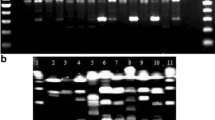Abstract
The purpose of this paper is to evaluate the utility of different typing methods for Achromobacter xylosoxidans clinical isolates. Ninety-two blood culture isolates of A. xylosoxidans subsp. xylosoxidans were collected over a 25-month period. The typeability, discriminatory power and reproducibility of commonly used phenotypic and genotypic methods, such as resistotyping, plasmid profiling, whole-cell protein fingerprinting, random amplification of polymorphic DNA (RAPD) and pulsed-field gel electrophoresis (PFGE), were compared. All 92 isolates were typeable by all of the methods used, with comparable reproducibility. PFGE showed the highest discriminatory power (98.9%), but whole-cell protein profiling showed better correlation with epidemiological data without significant loss in discriminatory power (94%). Whole-cell protein profiling is a reliable epidemiological tool for the analysis of A. xylosoxidans; PFGE is the most discriminatory.



Similar content being viewed by others
References
Duggan JM, Goldstein SJ, Chenoweth CE, Kauffman CA, Bradley SF (1996) Achromobacter xylosoxidans bacteremia: report of four cases and review of the literature. Clin Infect Dis 23:569–576
El-Shahawy MA, Kim D, Gadallah MF (1998) Peritoneal dialysis-associated peritonitis caused by Alcaligenes xylosoxidans. Am J Nephrol 18:452–455. doi:10.1159/000013370
Legrand C, Anaissie E (1992) Bacteremia due to Achromobacter xylosoxidans in patients with cancer. Clin Infect Dis 14:479–484
Weitkamp JH, Tang YW, Haas DW, Midha NK, Crowe JE Jr (2000) Recurrent Achromobacter xylosoxidans bacteremia associated with persistent lymph node infection in a patient with hyper-immunoglobulin M syndrome. Clin Infect Dis 31:1183–1187. doi:10.1086/317461
Vu-Thien H, Darbord JC, Moissenet D, Dulot C, Dufourcq JB, Marsol P et al (1998) Investigation of an outbreak of wound infections due to Alcaligenes xylosoxidans transmitted by chlorhexidine in a burns unit. Eur J Clin Microbiol Infect Dis 17:724–726. doi:10.1007/s100960050168
Granowitz EV, Keenholtz SL (1998) A pseudoepidemic of Alcaligenes xylosoxidans attributable to contaminated saline. Am J Infect Control 26:146–148. doi:10.1016/S0196-6553(98)80035-7
McGuckin MB, Thorpe RJ, Koch KM, Alavi A, Staum M, Abrutyn E (1982) An outbreak of Achromobacter xylosoxidans related to diagnostic tracer procedures. Am J Epidemiol 115:785–793
Cheron M, Abachin E, Guerot E, el-Bez M, Simonet M (1994) Investigation of hospital-acquired infections due to Alcaligenes denitrificans subsp. xylosoxydans by DNA restriction fragment length polymorphism. J Clin Microbiol 32:1023–1026
Kanellopoulou M, Pournaras S, Iglezos H, Skarmoutsou N, Papafrangas E, Maniatis AN (2004) Persistent colonization of nine cystic fibrosis patients with an Achromobacter (Alcaligenes) xylosoxidans clone. Eur J Clin Microbiol Infect Dis 23:336–339. doi:10.1007/s10096-004-1105-9
Tena D, Carranza R, Barberá JR, Valdezate S, Garrancho JM, Arranz M et al (2005) Outbreak of long-term intravascular catheter-related bacteremia due to Achromobacter xylosoxidans subspecies xylosoxidans in a hemodialysis unit. Eur J Clin Microbiol Infect Dis 24:727–732. doi:10.1007/s10096-005-0028-4
Tsay RW, Lin LC, Chiou CS, Liao JC, Chen CH, Liu CE et al (2005) Alcaligenes xylosoxidans bacteremia: clinical features and microbiological characteristics of isolates. J Microbiol Immunol Infect 38:194–199
Kumar A, Ray P, Kanwar M, Sethi S, Narang A (2006) Investigation of hospital-acquired infections due to Achromobacter xylosoxidans in a tertiary care hospital in India. J Hosp Infect 62:248–250. doi:10.1016/j.jhin.2005.07.016
Krzewinski JW, Nguyen CD, Foster JM, Burns JL (2001) Use of random amplified polymorphic DNA PCR to examine epidemiology of Stenotrophomonas maltophilia and Achromobacter (Alcaligenes) xylosoxidans from patients with cystic fibrosis. J Clin Microbiol 39:3597–3602. doi:10.1128/JCM.39.10.3597-3602.2001
Van Daele S, Verhelst R, Claeys G, Verschraegen G, Franckx H, Van Simaey L et al (2005) Shared genotypes of Achromobacter xylosoxidans strains isolated from patients at a cystic fibrosis rehabilitation center. J Clin Microbiol 43:2998–3002
Murray PR, Baron EJ, Pfaller MA, Tenover FC, Yolken RH (1999) Manual of clinical microbiology, 7th edn. ASM Press, Washington, DC
National Committee for Clinical Laboratory Standards (NCCLS) (2000) Performance standards for antimicrobial disc susceptibility testing (M2-A6), 7th edn. Clinical and Laboratory Standards Institute (CLSI), Wayne, PA
Sambrook J, Russell DW (2001) Molecular cloning: a laboratory manual, 3rd edn. Cold Spring Harbour Laboratory Press, New York
Brown A, Lema M, Ciesielski CA, Blaser MJ (1985) Combined plasmid and peptide analysis of clinical and environmental Legionella pneumophila strains associated with a small cluster of Legionnaires’ disease cases. Infection 13:163–166. doi:10.1007/BF01642803
Ausubel FM, Brent R, Kingston RE, Moore DD, Seidman JG, Smith JA et al (2002) Short protocols in molecular biology, 5th edn. Wiley, New York
Yao JD, Conly JM, Krajden M (1995) Molecular typing of Stenotrophomonas (Xanthomonas) maltophilia by DNA macrorestriction analysis and random amplified polymorphic DNA analysis. J Clin Microbiol 33:2195–2198
Bannerman TL, Hancock GA, Tenover FC, Miller JM (1995) Pulsed-field gel electrophoresis as a replacement for bacteriophage typing of Staphylococcus aureus. J Clin Microbiol 33:551–555
Tenover FC, Arbeit RD, Goering RV, Mickelsen PA, Murray BE, Persing DH et al (1995) Interpreting chromosomal DNA restriction patterns produced by pulsed-field gel electrophoresis: criteria for bacterial strain typing. J Clin Microbiol 33:2233–2239
Spear JB, Fuhrer J, Kirby BD (1988) Achromobacter xylosoxidans (Alcaligenes xylosoxidans subsp. xylosoxidans) bacteremia associated with a well-water source: case report and review of the literature. J Clin Microbiol 26:598–599
Shie SS, Huang CT, Leu HS (2005) Characteristics of Achromobacter xylosoxidans bacteremia in northern Taiwan. J Microbiol Immunol Infect 38:277–282
Boukadida J, Monastiri K, Snoussi N, Jeddi M, Berche P (1993) Nosocomial neonatal meningitis by Alcaligenes xylosoxidans transmitted by aqueous eosin. Pediatr Infect Dis J 12:696–697. doi:10.1097/00006454-199308000-00015
Knippschild M, Ansorg R (1998) Epidemiological typing of Alcaligenes xylosoxidans subsp. xylosoxidans by antibacterial susceptibility testing, fatty acid analysis, PAGE of whole-cell protein and pulsed field gel electrophoresis. Zentralbl Bakteriol 288:145–157
Lin YH, Liu PY, Shi ZY, Lau YJ, Hu BS (1997) Comparison of polymerase chain reaction and pulsed-field gel electrophoresis for the epidemiological typing of Alcaligenes xylosoxidans subsp. xylosoxidans in a burn unit. Diagn Microbiol Infect Dis 28:173–178. doi:10.1016/S0732-8893(97)00062-X
Author information
Authors and Affiliations
Corresponding author
Rights and permissions
About this article
Cite this article
Kaur, M., Ray, P., Bhatty, M. et al. Epidemiological typing of clinical isolates of Achromobacter xylosoxidans: comparison of phenotypic and genotypic methods. Eur J Clin Microbiol Infect Dis 28, 1023–1032 (2009). https://doi.org/10.1007/s10096-009-0740-6
Received:
Accepted:
Published:
Issue Date:
DOI: https://doi.org/10.1007/s10096-009-0740-6




